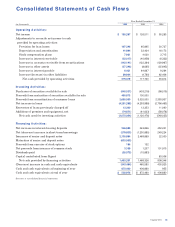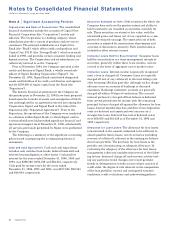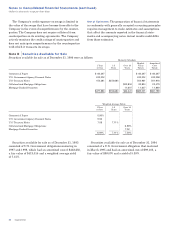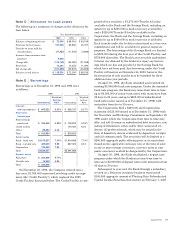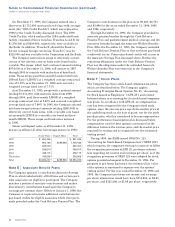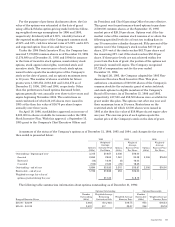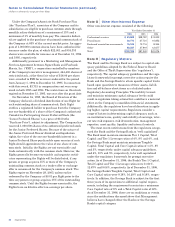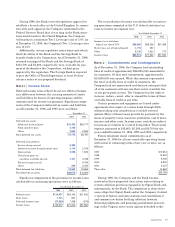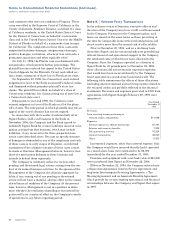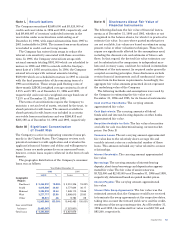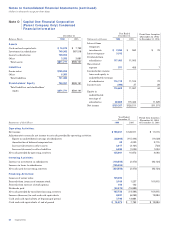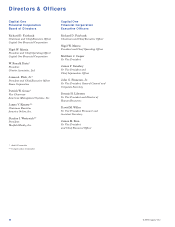Capital One 1996 Annual Report Download - page 50
Download and view the complete annual report
Please find page 50 of the 1996 Capital One annual report below. You can navigate through the pages in the report by either clicking on the pages listed below, or by using the keyword search tool below to find specific information within the annual report.
On November 17, 1995, the Company entered into a
three-year, $1,715,000 unsecured revolving credit arrange-
ment (the “1995 Credit Facility”), which was replaced in
1996 by the Credit Facility discussed above. The 1995
Credit Facility, which replaced the 1994 syndicated bank
facility, consisted of three tranches. Tranches A and B, for
$1,300,000 and $200,000, respectively, were available to
the Bank. In addition, Tranche B allowed the Bank to
borrow in major foreign currencies. Tranche C was for
$215,000 and was available to the Corporation and the Bank.
The Company entered into swaps to effectively convert
certain of the interest rates on bank notes from fixed to
variable. The swaps, which had a notional amount totaling
$974,000 as of December 31, 1996, will mature in 1997
through 2000 to coincide with maturities of fixed bank
notes. These swaps paid three-month London Interbank
Offered Rate (“LIBOR”) at a weighted average contractual
rate of 5.59% as of December 31, 1996 and received a
weighted average fixed rate of 7.71%.
As of December 31, 1995, swaps with a notional amount
totaling $1,014,000, with maturity dates from 1996
through 2000, paid three-month LIBOR at a weighted
average contractual rate of 5.69% and received a weighted
average fixed rate of 7.68%. In 1995, the Company entered
into basis swaps (notional amounts totaling $260,000) to
effectively convert bank notes, with a variable rate based
on six-month LIBOR to a variable rate based on three-
month LIBOR. These swaps and bank notes matured
in 1996.
Senior and deposit notes as of December 31, 1996,
mature as follows (all other borrowings mature in 1997):
Senior Notes Deposit Notes Total
1997 $ 891,436 $ 891,436
1998 800,166 $299,996 $1,100,162
1999 625,000 625,000
2000 599,614 599,614
2001 438,115 438,115
Thereafter 339,906 339,906
Total $3,694,237 $299,996 $3,994,233
Note E Associate Benefit Plans
The Company sponsors a contributory Associate Savings
Plan in which substantially all full-time and certain part-
time associates are eligible to participate. The Company
matches a portion of associate contributions and makes
discretionary contributions based upon the Company’s
earnings per common share. Effective January 1, 1996, the
Company is required to make additional contributions for
pay-based credits for eligible associates which were previ-
ously provided under the Cash Balance Pension Plan. The
Company’s contributions to this plan were $9,048, $2,701
and $3,890 for the years ended December 31, 1996, 1995
and 1994, respectively.
Through December 31, 1995, the Company provided its
associate pension benefits through the Cash Balance
Pension Plan and postretirement medical coverage and life
insurance benefits through the Associate Welfare Benefits
Plan. Effective December 31, 1995, the Company amended
the Cash Balance Pension Plan so that no future pay-based
credits will accrue. Future pay-based credits will accrue to
the Associate Savings Plan discussed above. Neither the
remaining obligations under the Cash Balance Pension
Plan nor the obligations under the unfunded Associate
Welfare Benefits Plan were material to the Company’s
financial statements.
Note F Stock Plans
The Company has three stock-based compensation plans
which are described below. The Company applies
Accounting Principles Board Opinion No. 25, “Accounting
for Stock Issued to Employees” (“APB 25”) and related
Interpretations in accounting for its stock-based compensa-
tion plans. In accordance with APB 25, no compensation
cost has been recognized for the Company’s fixed stock
options, since the exercise price equals the market price of
the underlying stock on the date of grant, nor for the stock
purchase plan, which is considered to be noncompensatory.
For the performance-based option plan discussed below,
compensation cost for these options is measured as the
difference between the exercise price and the market price
required for vesting and is recognized over the estimated
vesting period.
During 1995, the FASB issued SFAS No. 123,
“Accounting for Stock-Based Compensation” (“SFAS 123”)
which requires, for companies electing to continue to follow
the recognition provisions of APB 25, pro forma informa-
tion regarding net income and earnings per share, as if the
recognition provisions of SFAS 123 were adopted for stock
options granted subsequent to December 31, 1994. For
purposes of pro forma disclosure, the estimated fair value
of the options is amortized to expense over the options’
vesting period. For the year ended December 31, 1996 and
1995, the Company’s pro forma net income and earnings
per share information would have been $151,853, or $2.25
per share, and $125,296, or $1.88 per share, respectively.
48 Capital One
Notes to Consolidated Financial Statements (continued)
(dollars in thousands, except per share data)







